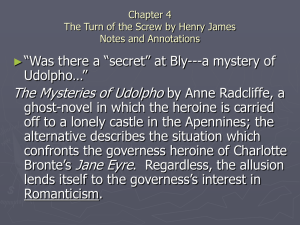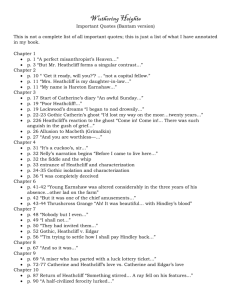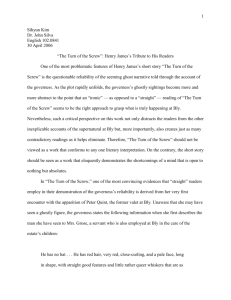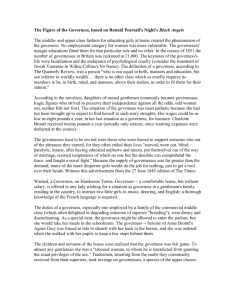English 3290
advertisement
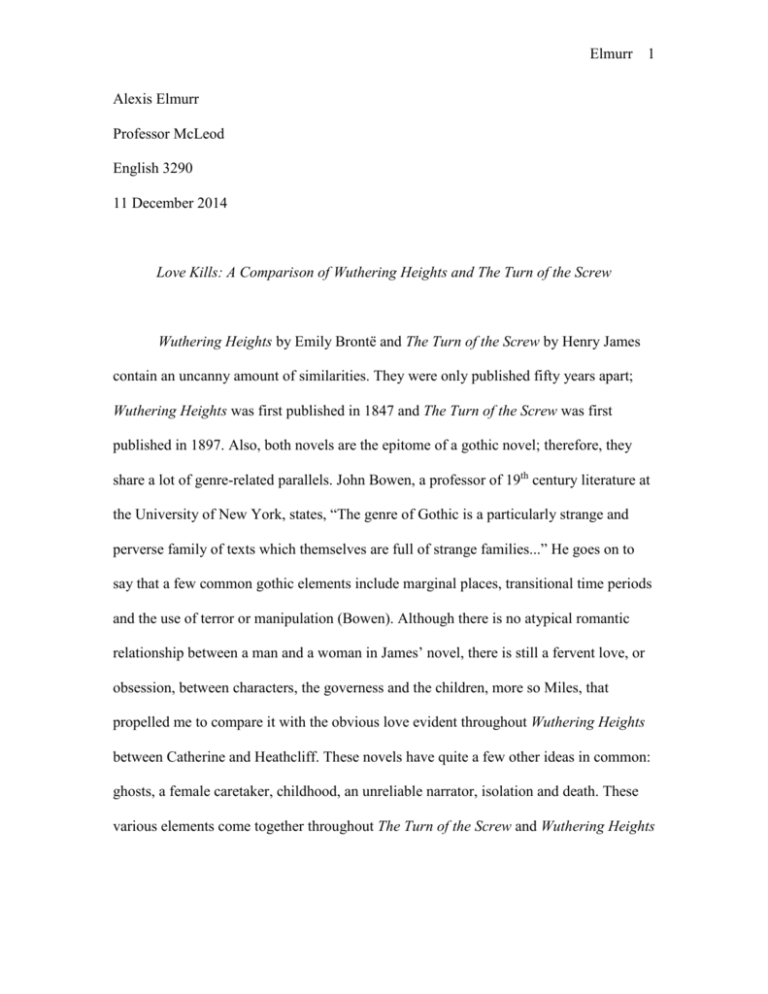
Elmurr 1 Alexis Elmurr Professor McLeod English 3290 11 December 2014 Love Kills: A Comparison of Wuthering Heights and The Turn of the Screw Wuthering Heights by Emily Brontë and The Turn of the Screw by Henry James contain an uncanny amount of similarities. They were only published fifty years apart; Wuthering Heights was first published in 1847 and The Turn of the Screw was first published in 1897. Also, both novels are the epitome of a gothic novel; therefore, they share a lot of genre-related parallels. John Bowen, a professor of 19th century literature at the University of New York, states, “The genre of Gothic is a particularly strange and perverse family of texts which themselves are full of strange families...” He goes on to say that a few common gothic elements include marginal places, transitional time periods and the use of terror or manipulation (Bowen). Although there is no atypical romantic relationship between a man and a woman in James’ novel, there is still a fervent love, or obsession, between characters, the governess and the children, more so Miles, that propelled me to compare it with the obvious love evident throughout Wuthering Heights between Catherine and Heathcliff. These novels have quite a few other ideas in common: ghosts, a female caretaker, childhood, an unreliable narrator, isolation and death. These various elements come together throughout The Turn of the Screw and Wuthering Heights Elmurr 2 in such a similar way that the commonality between them is very comparable, especially the use of ghosts, setting, unreliable narrators and obsession/possessiveness. William Veeder defines the gothic genre as “the simultaneous exploration of inner and outer” in his article, The Nurturance of Gothic (48). This directly relates to James’ novella because the entire plot, the governess, our narrator, is battling these supposed ghostly figures she keeps seeing, the outer, but the reader is internally debating the entire plot whether these ghosts are a figment of her imagination or if they actually exist. In Wuthering Heights, Catherine outwardly marries Edgar but always has a deep love for Heathcliff on the inside. Veeder goes on to discuss how gothic novels perform “selfhealing through terror” (49). In my opinion, this gothic detail is extremely noteworthy because it illustrates how in the gothic genre, no one can truly save a character besides him or herself. Catherine ultimately fails at saving herself after she basically goes mad after having to choose between her two lovers (Brontë 172). The terror is also vividly seen in The Turn of the Screw because the whole tale itself is a ghost story; however, I am unsure of exactly what self-healing the governess is experiencing. Perhaps the selfhealing is the job itself; the governess having a place in society/in a family is enough to heal her internally. Bowen references Ann Radcliffe while discussing terror in gothic Victorian novels and states, “Terror… could be morally uplifting. It does not show horrific things explicitly but only suggests them… [It] ‘expands the soul’ of the readers of her works and helps them to be more alert to the possibility of things beyond their everyday life and understanding.” Veeder also writes an interesting view about how The Turn of the Screw has a fascinating mirror effect. He astutely points out that the first verb of the first sentence and the last verb of the penultimate sentence are the same—“held” Elmurr 3 (Veeder 50). This clever mirroring device is also blatantly used throughout the entirety of the plot of Wuthering Heights. Furthermore, both of the novels’ settings involve complete isolation from the outside world, and the setting remains isolated for most, if not all, of each novel. However, I believe the isolation in each novel serves a different purpose. The isolation in The Turn of the Screw seems to make the story even creepier but I would not describe Wuthering Heights as incredibly creepy, although it is incredibly dark. Wuthering Heights utilizes the isolation of the Heights and the Grange in order to further the mirroring effect discussed earlier—both houses hold two different families/generations that begin to repeat the same patterns of the other household and of the past. It is neat to realize how the same literary tool can be used so effectively yet so differently for each novel. A small detail that strikes as another similarity is the female roles of Nelly and Mrs. Grose in Wuthering Heights and The Turn of the Screw, respectively. Both women are not actually family but are close enough to be in on all of the family secrets. They provide an interesting point of view, especially Nelly considering she is the narrator for most of Wuthering Heights. I consider Nelly to be a fairly decent narrator; nonetheless, every narrator is biased, unless it is third-person omniscient, so Nelly is not a completely reliable narrator. She was clearly not fond of older Catherine thus probably telling the tale a bit differently than the true tale. In The Turn of the Screw, the reader never even learns the narrator’s name and is questioning the entire story if the governess, our narrator, is sane or not. Clearly, the narrator is not very reliable. I would venture to say that Nelly is a more reliable narrator than the governess because the only evidence the Elmurr 4 governess has in the novel is a lack of evidence—the absence of things, while Nelly does not really require any evidence for her tale to come across as, mostly, truthful. Veeder makes a comment in his article about The Turn of the Screw dealing with its negative evidence; “What strikes me most here is what’s not here” (63). Veeder goes on to discuss an interesting in-depth analysis of the governess’ psychological state when she arrives at Bly. He brings up the moment at the beginning of the novel when she hears “faint and far, the cry of a child” and another night when she hears a “light footstep” (James 31). Veeder states that hearing a cry of a child is high improbable because Miles is away at school and Flora is two whole floors below the governess; therefore, she did not have the ability to hear her (67). Moreover, the light footsteps would not be Mrs. Grose because even the governess has very loud footsteps in the hallway and it would not be Flora who is happily sleeping with Mrs. Grose (Veeder 67). From the very beginning, the governess seems to have “brought her troubles with her,” and appears to be unreliable to the reader (Veeder 67). All in all, both novels contain the element of an unreliable narrator; I would just simply argue that the governess is more so. The last, and I believe most important, comparison I wish to make involves the possessive love between Catherine and Heathcliff from Wuthering Heights and the governess and the children from The Turn of the Screw. Both relationships are not completely romantic in the sense that they are not pure. They include manipulation and/or obsession, which clearly indicate an impure intention. In an unsigned review of Wuthering Heights, the writer states, “There is a selfishness—a ferocity in the love of Heathcliff, which scarcely suffer it, in spite of its rugged constancy, to relieve the darker parts of his nature” (355). Furthermore, their love is definitely an unhappy one, as Elmurr 5 Catherine “…wayward, impatient, impulsive—sacrifices herself and her lover to the pitiful ambition of becoming the wife of a gentleman of station” (355). One of the scenes that truly captures the selfishness of Heathcliff’s love for Catherine is right after Catherine’s death in Chapter 16. Nelly is saying how she hopes Catherine wakes “kindly in the other world,” but Heathcliff feels differently: ‘May she wake in torment!’ he cried, with frightful vehemence, stamping his foot, and groaning in a sudden paroxysm of ungovernable passion. ‘Why, she’s a liar to the end. Where is she? Not there—not in heaven— not perished—where?—Oh! You said you cared nothing for my sufferings! And I pray one prayer—I repeat it till my tongue stiffens— Catherine Earnshaw, may you not rest, as long as I am living! You said I killed you—haunt me, then! The murdered do haunt their murderers, I believe—I know that ghosts have wandered on earth. Be with me always—take any form—drive me mad! only do not leave me in this abyss, where I cannot find you! Oh, God! it is unutterable! I cannot live without my life! I cannot live without my soul!’ (Brontë 175). This quotation perfectly illustrates the obsession Heathcliff had with his beloved Cathy. Plus, it is in the perfect place in the novel to point out how this unhealthy love ultimately led to Catherine’s demise, like how the governess’ love ultimately led to Miles’ death at the very end of The Turn of the Screw. The unhealthiness of Catherine and Heathcliff’s love is demonstrated right before her death in a scene where the two lovers are fighting Elmurr 6 yet professing their love. This scene also illustrates their obsession for each other as well as how Catherine’s death is directly caused by Heathcliff. Catherine says, “You and Edgar have broken my heart, Heathcliff… You have killed me—and thriven on it, I think” (Brontë 168). Catherine goes on to bitterly exclaim, “I wish I could hold you till we were both death! I shouldn’t care what you suffered. I care nothing for your sufferings. Why shouldn’t you suffer? I do!” (168). Catherine does go on to say sweeter things, but the sting and violence of this sentiment still rings on. Although Heathcliff is usually portrayed as the villain of this novel, Catherine is just as responsible for their tortured love. The biggest reason their adoration is so corrupt is because instead of wishing the very best for each other, what we are taught means to truly love somebody, they both simply wish to always be together, no matter the consequences the other or he/herself would face: “I’m not wishing you greater torment than I have, Heathcliff! I only wish us never to be parted…” (Brontë 169). Unarguably, Heathcliff and Catherine’s love is powerful yet destructive. This ugly possessiveness is what Wuthering Heights and The Turn of the Screw share. nnnnnIn The Turn of the Screw, the obsession is very much there; however, it is much more subtle, in my opinion, than the obsession in Wuthering Heights. A reason for this is because during a first read, the governess comes across as kind-hearted and good-natured, incapable of such suspiciousness. Nonetheless, after more readings and sifting through various criticisms of the novel, one realizes the potential possessiveness the governess has for the children, specifically Miles. A review from Recommended Reading: 500 Classics Reviewed states, “The story centers on the struggle between the governess and the ghosts for the children’s souls, with the added hint that the real evil may lie in the Elmurr 7 governess’ possessiveness. The evil is real—that much at least is clear, in this deliberately ambiguous tale which has haunted the imaginations of generations of readers.” It is clear from the beginning that the governess has a fascination with the children based off of the descriptions James’ provides us: “The little girl who accompanied Mrs. Grose affected me on the spot as a creature too charming not to make it a great fortune to have to do with her… She was the most beautiful child I had ever seen…”(James 30). The governess goes on to profess, “But it was a comfort that there would be no uneasiness in a connexion with anything so beatific as the radiant image of my little girl, the vision of whose angelic beauty had probably more than anything else to do with the restlessness…” (30). These scenes are the very first interaction the governess has with Flora, and she is completely awe-struck. It is also important that the narrator specifically used the word “my” to describe the little girl, when the governess had only just arrived at Bly. Furthermore, Mrs. Grose and the governess have an exchange that foreshadows the relationship between Miles and herself: ‘You will be carried away by the little gentleman!’ ‘Well, that, I think, is what I came for—to be carried away’” (James 31). The relationship between Miles and the governess is a bit odd at times, sometimes with a hint of a romance between them. A few moments in the novel make the reader tilt their head, such as when they are in the dining room waiting for the maid to leave the room: We continued silent while the maid was with us – as silent, it whimsically occurred to me, as some young couple who, on their wedding journey, at the inn, feel shy in the presence of the waiter. He turned round only when the waiter had left us. ‘Well—so we’re alone!’ (James 113). Elmurr 8 The comparison of her and Miles to a married couple, an allusion to Mary and Joseph as well, is odd and makes the reader question, if only for a moment, the relationship between them. The biggest parallel I wish to discuss between Wuthering Heights and The Turn of the Screw is the untimely death of Miles, like Catherine, and how it was caused by possessiveness. In A Critical History, it says, “It is impossible, in any case, for readers not to pay some attention to Miles’s death… in the last line of the story, and that stopping cries out to be explained” (Beidler 251). It also states, “The governess is now suspect, and readers focus more and more on her questionable motives, on possible inconsistencies in her narrative, and on her own psychology. They see her … as a lovestarved woman for whom the various “characters” in the novel… shadow forth repressed aspects of her own clouded personality” (245). Obviously, there are many, many theories as to what exactly is the cause of Miles’s death but I believe the obsession of the governess is what caused his death, either directly or indirectly. The very scene itself involves her fiercely holding, or possessively smuggling him: I caught him, yes, I held him—it may be imagined with what a passion; but at the end of a minute I began to feel what it truly was that I held. We were alone with the quiet day, and his little heart, dispossessed, had stopped (James 120). She was holding him “with what a passion” and finally, as he died he was officially “dispossessed” by all the evil and from the governess. The unreliability of the narrator, the governess, as well as the enigmatic nature of The Turn of the Screw make it difficult Elmurr 9 to effectively analyze this scene; nonetheless, I firmly believe it was the governess’s obsession with the children, specifically Miles, that ultimately caused his death. All in all, the similarities between Wuthering Heights and The Turn of the Screw are almost eerie. This may mostly be because they both belong to the gothic genre, thus sharing many gothic qualities. However, it is also specifically because of the setting, unreliable narrators and the selfish, possessive love evident in both novels. Elmurr 10 Works Cited “Appendix D: Contemporary Reponses to the Novel.” Appendix. Wuthering Heights. By nnnnnEmily Brontë. Broadview Press, 2007. 345-373. Bowen, John. “Gothic Motifs.” Bl.uk. British Library, 5 Dec. 2012. Web. 2 Dec 2014. Beidler, Peter G. “A Critical History of The Turn of the Screw.” Afterword. The Turn of nnnnnthe Screw. By Henry James. Bedford/ St. Martins, 2010. 235-261. Print. Brontë, Emily. Wuthering Heights. 1847. Ed. Beth Newman. Toronto: Broadview Press, nnnnn2007. Print. James, Henry. The Turn of the Screw. 1897. 3rd ed. Ed. Peter G. Beidler. Botson: nnnnnBedford/ St. Martin’s, 2010. Print. "The Turn Of The Screw." Recommended Reading: 500 Classics Reviewed (1995): 1. nnnnnLiterary Reference Center. Web. 30 Nov. 2014. Veeder, William. “The Nurturance of Gothic.” Gothic Studies 1.1 (1999): 47. Academic nnnnnSearch Complete. Web. 30 Nov. 2014.

